-
-
Access Free Student Software
Ansys empowers the next generation of engineers
Students get free access to world-class simulation software.
-
Connect with Ansys Now!
Design your future
Connect with Ansys to explore how simulation can power your next breakthrough.
Countries & Regions
Free Trials
Products & Services
Learn
About
Back
Products & Services
Back
Learn
Ansys empowers the next generation of engineers
Students get free access to world-class simulation software.
Back
About
Design your future
Connect with Ansys to explore how simulation can power your next breakthrough.
Free Trials
ANSYS BLOG
April 16, 2024
Simulation to Save Art: Predicting the Deterioration of Ancient Thai Murals with CFD
Classic art stands the test of time — or does it? Paintings such as the “Mona Lisa” or “The Starry Night” garner attention centuries after their creation. Famous murals like “The Last Supper” not only draw crowds, but also reside in architectural marvels named World Heritage Sites by the United Nations Educational, Scientific, and Cultural Organization (UNESCO). But as timeless as art may seem, it requires maintenance, preservation, and, in some cases, restoration.
What if we could anticipate art deterioration and, in turn, prevent it? Or study which materials and substances endure best to replicate them for use in future paintings? An assistant professor at the Rajamangala University of Technology Suvarnabhumi in Thailand is using Ansys simulation to research these possibilities in the historic city of Ayutthaya — the country’s former capital and a UNESCO World Heritage Site since 1991.
A computational fluid dynamics (CFD) enthusiast, Mongkol Kaewbumrung, Ph.D., is leveraging Ansys Fluent and other simulation tools through the Ansys Academic Program to prevent the deterioration of ancient Thai murals at a monastery in Ayutthaya. By analyzing environmental conditions as well as the chemical composition of the artwork itself, Kaewbumrung hopes to unlock new possibilities for art preservation and improve future art techniques.
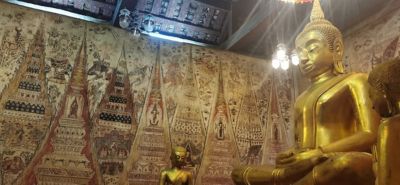
Ancient mural at Wat Ko Kaeo Suttharam in Phetchaburi, Thailand.
Exploring Ancient Art
Home to some of Thailand’s finest art and culture, Ayutthaya was established as one of the region’s greatest cities and flourished between the 14th and 18th centuries. Sadly, much of Ayutthaya was destroyed by war in 1767.
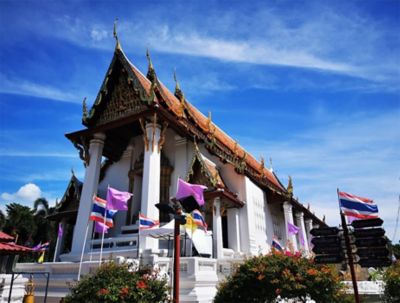
Wat Na Phramen monastery in the historic city of Ayutthaya in Thailand.
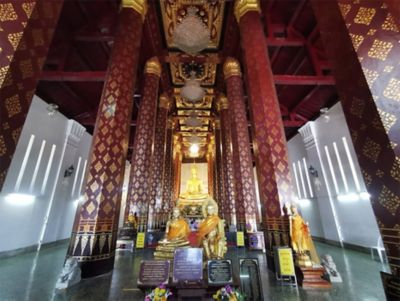
Wat Na Phramen houses an ordination hall and statue of the Buddha.
Murals were popular in the ancient Thai royal palace. One example is the wall painting at Wat Ko Kaeo Suttharam in Phetchaburi, which dates back to the 18th century. Although the pigments used in the mural can last for long periods of time, an accumulation of humidity can lead to deterioration.
“Fortunately, progress in advanced engineering, mathematics, and parallel computing — and its integration with architecture and archeology — widens the opportunity to forecast the flow and distribution of humidity,” says Kaewbumrung. “This knowledge can be used to anticipate the deterioration of Ayutthaya’s murals and design preventive procedures, leading to new science-based innovation for restoration.”
This motivated Kaewbumrung to examine murals and artwork at the Wat Na Phramen monastery (formerly known as Wat Phra Merurachikaram) — one of the only surviving temples in Ayutthaya, with fine art more than 500 years old.
The monastery houses an ordination hall, measuring 50 m in length and 16 m in width, along with a statue of the Buddha. The walls of the ordination hall feature vents and balustrades that create apertures in which sunlight and wind can pass through. Its ceiling is designed with ancient wooden mandalas that are lacquered in black and gold and ornamented with glass.
Leveraging CFD to Predict Art’s Fate
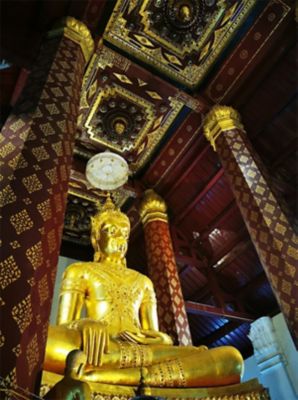
The ceiling of Wat Na Phramen features ancient wooden mandalas that are lacquered in black and gold.
To study how environmental conditions at the monastery impact its art, Kaewbumrung prepared 3D models of art samples using Ansys SpaceClaim and Ansys DesignModeler, then constructed mesh in Ansys Fluent Mosaic Meshing. Mosaic mesh enables researchers to transition between varying types of mesh, including polyhedral, hexahedral, and isotropic poly prism elements. The technique significantly reduces the required time for grid creation and maintains high quality for a transient flow analysis in Fluent, which examines unsteady flow behavior better than a steady-state modeling approach.
The time-saving aspects of Fluent’s Mosaic Meshing capability were especially helpful because Kaewbumrung constructed his grids using more than 12 million units of mesh, including about 5 million polyhedral, 4 million hexahedral, and 3 million isotropic poly prism elements. He also conducted a separate independent analysis of the grid using a shear stress transport (SST) k-omega (k-w) model.
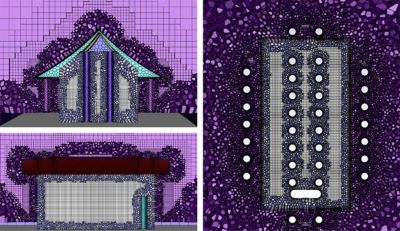
More than 12 million units of mesh were constructed using Ansys Fluent Mosaic Meshing and included a mix of polyhedral, hexahedral, and isotropic poly prism elements.
He ran the simulations on 64 cores at a computer lab at Kasetsart University in Bangkok, leveraging Ansys’ high-performance computing (HPC) and parallel processing capabilities in Fluent and its Mosaic Meshing capability. Other Ansys CFD solutions were also used, such as Ansys EnSight, a data visualization tool that can process models containing hundreds of millions of cells.
After Kaewbumrung created the grids, he defined boundary conditions for fluidity and humidity distribution using weather data supplied by the meteorological department for the central region of Thailand during March and April 2021. Numbers from actual measurements were included in the database to obtain average values and verify the accuracy of the simulation.
“From the calculation, it is shown that Fluent can retrieve wind velocity in the ordination hall with outstanding consistency to the actual measurements,” says Kaewbumrung.
Gaining Insight into Painting Preservation
Although the ordination hall’s apertures provided a fair amount of ventilation for centuries — a clever design that Kaewbumrung calls “ancient air conditioning” — current CFD simulations show a large vortex of humidity and temperature.
This is due to increased climate change, pollution, and urbanization, he says. These environmental conditions negatively impact the air quality and wind outside, which enters into the monastery and affects the murals. In addition, underground moisture affects the monastery’s structure.
Kaewbumrung’s research confirms that humidity plays a role in mural deterioration and illustrates an accurate way to detect and monitor it. This offers critical insight into prevention and maintenance techniques. For example, learning that some of the ancient organic colors endured fairly well, considering they’ve been exposed to hundreds of years of humidity, led him to examine their composition more closely so we can improve present-day materials.
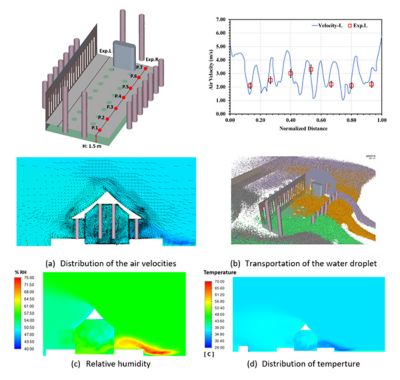
A comparison of Ansys Fluent simulations to actual measurements illustrates high accuracy for the air velocity models.
“These organic substances can transfer the moisture and temperature better than the current chemical ones, as they can permeate moisture from the inner wall through to the air without degeneration of the painting,” he says. “Therefore, understanding the chemical compositions, molecular structure, binding, and interaction of interlayers can initiate the invention of colors equivalent to the original ones, which is the key to sustainable restoration of the priceless historic sites.”
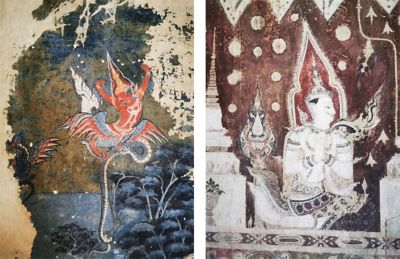
Mural paintings at the temples Wat Chang Yai (left) and Wat Mai Pra Chumpol (right) in Ayutthaya demonstrate the longevity of ancient organic substances versus chemical colors, which peel off the wall (as seen in the background of the left mural).
Shining a Light with Simulation
According to Kaewbumrung, simulation is crucial to restoration efforts.
“This research will not be achieved without a well-developed software equipped with required features,” he says. “With advanced progress in computational technology combined with the remarkable capabilities of Ansys SpaceClaim, Ansys Fluent Mosaic Meshing, Ansys Fluent, and Ansys EnSight, as well as Ansys’ parallel processing capabilities, we can utilize engineering and mathematical knowledge to research art and archeology successfully.”
To learn more about Ansys’ support for students, educators, and researchers, visit Ansys Academic.